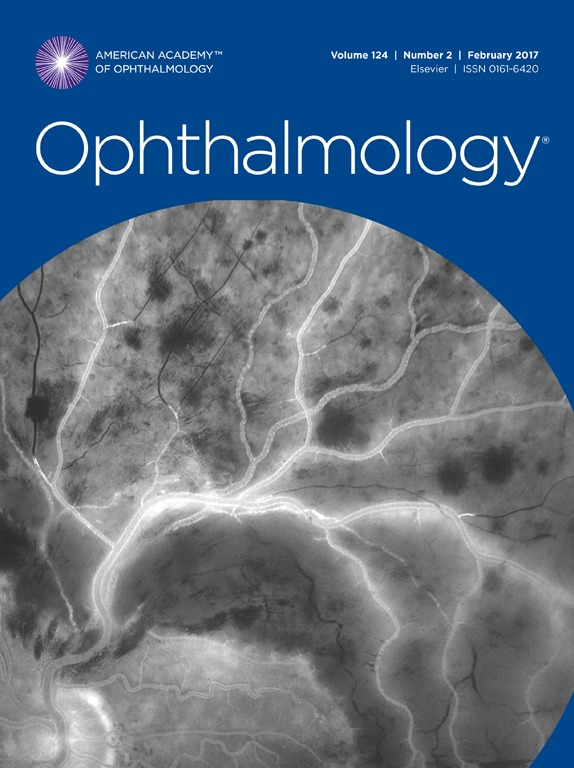Disease Activity and Therapeutic Response to Pegcetacoplan for Geographic Atrophy Identified by Deep Learning-Based Analysis of OCT
IF 13.1
1区 医学
Q1 OPHTHALMOLOGY
引用次数: 0
Abstract
Purpose
To quantify morphological changes of the photoreceptors (PRs) and retinal pigment epithelium (RPE) layers under pegcetacoplan therapy in geographic atrophy (GA) using deep learning–based analysis of OCT images.
Design
Post hoc longitudinal image analysis.
Participants
Patients with GA due to age-related macular degeneration from 2 prospective randomized phase III clinical trials (OAKS and DERBY).
Methods
Deep learning–based segmentation of RPE loss and PR degeneration, defined as loss of the ellipsoid zone (EZ) layer on OCT, over 24 months.
Main Outcome Measures
Change in the mean area of RPE loss and EZ loss over time in the pooled sham arms and the pegcetacoplan monthly (PM)/pegcetacoplan every other month (PEOM) treatment arms.
Results
A total of 897 eyes of 897 patients were included. There was a therapeutic reduction of RPE loss growth by 22% and 20% in OAKS and 27% and 21% in DERBY for PM and PEOM compared with sham, respectively, at 24 months. The reduction on the EZ level was significantly higher with 53% and 46% in OAKS and 47% and 46% in DERBY for PM and PEOM compared with sham at 24 months. The baseline EZ-RPE difference had an impact on disease activity and therapeutic response. The therapeutic benefit for RPE loss increased with larger EZ-RPE difference quartiles from 21.9%, 23.1%, and 23.9% to 33.6% for PM versus sham (all P < 0.01) and from 13.6% (P = 0.11), 23.8%, and 23.8% to 20.0% for PEOM versus sham (P < 0.01) in quartiles 1, 2, 3, and 4, respectively, at 24 months. The therapeutic reduction of EZ loss increased from 14.8% (P = 0.09), 33.3%, and 46.6% to 77.8% (P < 0.0001) between PM and sham and from 15.9% (P = 0.08), 33.8%, and 52.0% to 64.9% (P < 0.0001) between PEOM and sham for quartiles 1 to 4 at 24 months.
Conclusions
Deep learning-based OCT analysis objectively identifies and quantifies PR and RPE degeneration in GA. Reductions in further EZ loss on OCT are even higher than the effect on RPE loss in phase 3 trials of pegcetacoplan treatment. The EZ-RPE difference has a strong impact on disease progression and therapeutic response. Identification of patients with higher EZ-RPE loss difference may become an important criterion for the management of GA secondary to AMD.
Financial Disclosure(s)
Proprietary or commercial disclosure may be found after the references.
通过基于深度学习的光学视网膜成像(OCT)分析,确定治疗地理性萎缩的疾病活动和对培高康的治疗反应。
目的:利用基于深度学习的光学相干断层扫描(OCT)图像分析方法,量化地理萎缩(GA)患者在培高康治疗下感光器(PR)和视网膜色素上皮(RPE)层的形态学变化:事后纵向图像分析:方法:基于深度学习对 SD-OCT 图像上 24 个月的 RPE 损失和 PR 退化(定义为 OCT 上椭圆形区 (EZ) 层的损失)进行分割:假治疗组和每月(PM)/每隔一个月(PEOM)治疗组的 RPE 和 EZ 平均损失面积随时间的变化 结果:共纳入了 897 名患者的 897 只眼睛。24 个月时,与假性治疗相比,OAKS 和 DERBY 的 PM/PEOM 治疗分别减少了 22%/20% 和 27%/21% 的 RPE 损耗增长。在24个月时,与假性疗法相比,OAKS和DERBY治疗PM/PEOM的EZ水平下降幅度分别为53%/46%和47%/46%。基线 EZ-RPE 差异对疾病活动性和治疗反应有影响。PM 与假体相比,随着 EZ-RPE 差异四分位数从 21.9%、23.1%、23.9% 到 33.6%(所有 pConclusion)的增大,RPE 损失增长的治疗获益也随之增加:基于 OCT 的 AI 分析客观地识别和量化了 GA 中的 PR 和 RPE 退化。OCT 上与 EZ 损失一致的 PR 退化的进一步减少甚至高于培加氯铵治疗 3 期试验中对 RPE 损失的影响。EZ-RPE 差异对疾病进展和治疗反应有很大影响。识别 EZ-RPE 损失差异较高的患者可能成为治疗继发于 AMD 的 GA 的一个重要标准。
本文章由计算机程序翻译,如有差异,请以英文原文为准。
求助全文
约1分钟内获得全文
求助全文
来源期刊

Ophthalmology
医学-眼科学
CiteScore
22.30
自引率
3.60%
发文量
412
审稿时长
18 days
期刊介绍:
The journal Ophthalmology, from the American Academy of Ophthalmology, contributes to society by publishing research in clinical and basic science related to vision.It upholds excellence through unbiased peer-review, fostering innovation, promoting discovery, and encouraging lifelong learning.
 求助内容:
求助内容: 应助结果提醒方式:
应助结果提醒方式:


